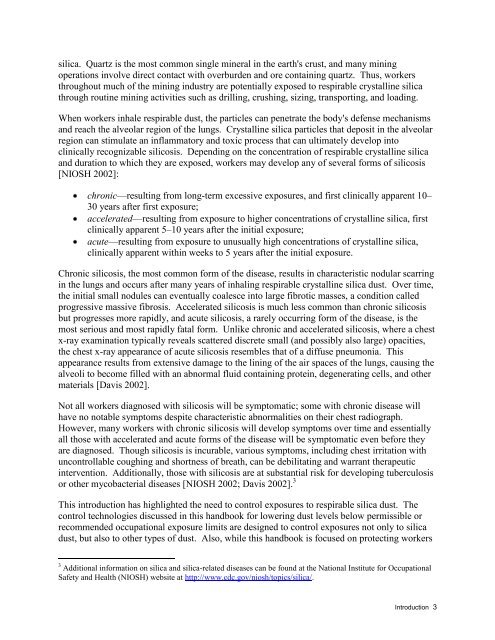Dust Control Handbook for Industrial Minerals Mining and Processing
Dust Control Handbook for Industrial Minerals Mining and Processing
Dust Control Handbook for Industrial Minerals Mining and Processing
You also want an ePaper? Increase the reach of your titles
YUMPU automatically turns print PDFs into web optimized ePapers that Google loves.
silica. Quartz is the most common single mineral in the earth's crust, <strong>and</strong> many miningoperations involve direct contact with overburden <strong>and</strong> ore containing quartz. Thus, workersthroughout much of the mining industry are potentially exposed to respirable crystalline silicathrough routine mining activities such as drilling, crushing, sizing, transporting, <strong>and</strong> loading.When workers inhale respirable dust, the particles can penetrate the body's defense mechanisms<strong>and</strong> reach the alveolar region of the lungs. Crystalline silica particles that deposit in the alveolarregion can stimulate an inflammatory <strong>and</strong> toxic process that can ultimately develop intoclinically recognizable silicosis. Depending on the concentration of respirable crystalline silica<strong>and</strong> duration to which they are exposed, workers may develop any of several <strong>for</strong>ms of silicosis[NIOSH 2002]:chronic—resulting from long-term excessive exposures, <strong>and</strong> first clinically apparent 10–30 years after first exposure;accelerated—resulting from exposure to higher concentrations of crystalline silica, firstclinically apparent 5–10 years after the initial exposure;acute—resulting from exposure to unusually high concentrations of crystalline silica,clinically apparent within weeks to 5 years after the initial exposure.Chronic silicosis, the most common <strong>for</strong>m of the disease, results in characteristic nodular scarringin the lungs <strong>and</strong> occurs after many years of inhaling respirable crystalline silica dust. Over time,the initial small nodules can eventually coalesce into large fibrotic masses, a condition calledprogressive massive fibrosis. Accelerated silicosis is much less common than chronic silicosisbut progresses more rapidly, <strong>and</strong> acute silicosis, a rarely occurring <strong>for</strong>m of the disease, is themost serious <strong>and</strong> most rapidly fatal <strong>for</strong>m. Unlike chronic <strong>and</strong> accelerated silicosis, where a chestx-ray examination typically reveals scattered discrete small (<strong>and</strong> possibly also large) opacities,the chest x-ray appearance of acute silicosis resembles that of a diffuse pneumonia. Thisappearance results from extensive damage to the lining of the air spaces of the lungs, causing thealveoli to become filled with an abnormal fluid containing protein, degenerating cells, <strong>and</strong> othermaterials [Davis 2002].Not all workers diagnosed with silicosis will be symptomatic; some with chronic disease willhave no notable symptoms despite characteristic abnormalities on their chest radiograph.However, many workers with chronic silicosis will develop symptoms over time <strong>and</strong> essentiallyall those with accelerated <strong>and</strong> acute <strong>for</strong>ms of the disease will be symptomatic even be<strong>for</strong>e theyare diagnosed. Though silicosis is incurable, various symptoms, including chest irritation withuncontrollable coughing <strong>and</strong> shortness of breath, can be debilitating <strong>and</strong> warrant therapeuticintervention. Additionally, those with silicosis are at substantial risk <strong>for</strong> developing tuberculosis3or other mycobacterial diseases [NIOSH 2002; Davis 2002].This introduction has highlighted the need to control exposures to respirable silica dust. Thecontrol technologies discussed in this h<strong>and</strong>book <strong>for</strong> lowering dust levels below permissible orrecommended occupational exposure limits are designed to control exposures not only to silicadust, but also to other types of dust. Also, while this h<strong>and</strong>book is focused on protecting workers3Additional in<strong>for</strong>mation on silica <strong>and</strong> silica-related diseases can be found at the National Institute <strong>for</strong> OccupationalSafety <strong>and</strong> Health (NIOSH) website at http://www.cdc.gov/niosh/topics/silica/.Introduction 3

















